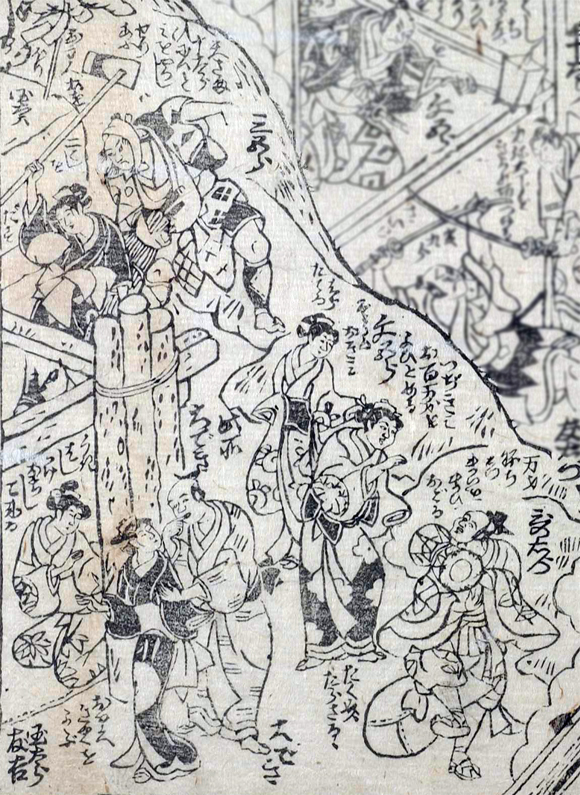| SHICHIJď KAWARA |
| Play title | Taiheiki Chűshin K˘shaku The Chronicle of Great Peace and a Lecture about the Loyal Retainers |
| Common title | Shichij˘ Kawara |
| Authors | Chikamatsu Hanji Miyoshi Sh˘raku Takeda Koizumo I Takemoto Saburobŕ II Takeda Bungo Takeda Heishichi |
| History |
The puppet theater drama "Taiheiki Chűshin K˘shaku" was premiered in ďsaka at the Takemotoza in the 10th lunar month of 1766. It was quickly adapted to Kabuki the following year and was premiered in the 2nd lunar month of 1767 in Edo at the Ichimuraza [casting]. It was quite popular during the Edo period, especially the "Kinai Sumika" scene but, most likely due to the cruelty of some scenes [1], it is nowadays a rarely-staged drama. Only one revival for "Taiheiki Chűshin K˘shaku", without the "Shichij˘ Kawara" or "Kinai Sumika" scene, in July 1966 in T˘ky˘ at the T˘yoko Hall. We do hope that it will be revived at the National Theatre in the future to come! |
| Structure |
The original drama was in 10 acts (12 scenes). Only 5 acts (6 scenes) have survived. "Shichij˘ Kawara" was the sole scene of the 6th act of "Taiheiki Chűshin K˘shaku". |
| Key words |
Adauchi Adauchimono Ageya Ak˘ R˘shi Ashikaga Tadayoshi Chűshin Chűshinguramono Gidayű Ky˘gen Gion Giri/Ninj˘ Gishi Gishi Ky˘gen H˘s˘ Kawara Manzaishi Kuruwa R˘nin Sarumawashi Shichij˘ S˘ka Taiheiki Yűjo |
| Summary |
The scene is set on the dry bed (kawara) of the Kamo River near Ky˘to Seventh Avenue (Shichij˘), a place where it is possible to get cheap entertainment from prostitution to dance performances (manzaishi or sarumawashi). When prostitutes (s˘ka) Ohyaku and Okimi are touting, a day laborer buries a letterbox in the sand and goes away. Orie, an elegant-looking woman pretending to be a prostitute, appears and, taking a kind customer into a night watchman's hut, asks for and receives money from him without prostituting herself. She is in fact the wife of Yazama Jűtar˘, a former retainer of a feudal lord who was executed for his attack on his arrogant superior with a drawn sword in the Shogunate palace. She is hard up because not only her husband is unemployed, being intent on avenging his former master's death, but also her father-in-law Yazama Kinai is ill in bed and her son Taichir˘ is suffering from the smallpox (h˘s˘). A beggar comes to dig out the letterbox. Then, he buries in its place a package containing money and he goes away. Ukihashi, a courtesan from Gion, then arrives and asks the prostitutes to help her hide because she is being chased by employees of the tea house from which she has run away. The prostitutes comply with her request and the search team from the kuruwa goes away without finding her. Ukihashi, who is in fact Jűtar˘'s younger sister Omutsu, meets Orie and recognizes her as her sister-in-law. After Omutsu and the prostitutes have gone away, Orie tries to dig out the package when the beggar, who in fact is Jűtar˘ in disguise, comes back to claim it. They recognize each other as man and wife. |
 |
|
An illustration from an ezukushi banzuke depicting the "Shichij˘ Kawara" act of the drama "Taiheiki Chűshin K˘shaku", which was staged in the 8th lunar month of 1795 in ďsaka at the Kado no Shibai with Arashi Sangor˘ II, Sawamura Kunitar˘ I, Fujikawa Tomokichi I and Nakamura Utaemon III in the roles of Yazama Jűtar˘, Orie, Ukibashi and a manzaishi |
|
|
| Contact | Main | Top | Updates | Actors | Plays | Playwrights | Programs | Links | FAQ | Glossary | Chronology | Illustrations | Prints | Characters | Derivatives | Theaters | Coming soon | News |